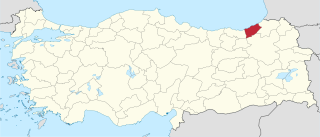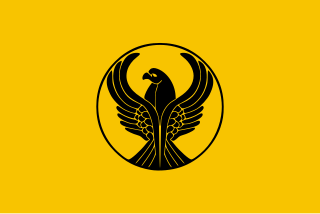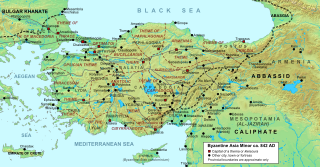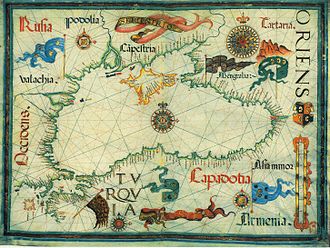
The Black Sea is a marginal mediterranean sea of the Atlantic Ocean lying between Europe and Asia; east of the Balkan Peninsula, south of the East European Plain in Eastern Europe, west of the Caucasus, and north of Anatolia in Western Asia. It is supplied by major rivers, principally the Danube, Dnieper, and Don. The watersheds of many countries drain into the sea beyond the six that share its coast.

Trabzon, historically known as Trebizond in English, is a city on the Black Sea coast of northeastern Turkey and the capital of Trabzon Province. Trabzon, located on the historical Silk Road, became a melting pot of religions, languages and culture for centuries and a trade gateway to Persia in the southeast and the Caucasus to the northeast. The Venetian and Genoese merchants paid visits to Trabzon during the medieval period and sold silk, linen and woolen fabric. Both republics had merchant colonies within the city – Leonkastron and the former "Venetian castle" – that played a role to Trabzon similar to the one Galata played to Constantinople. Trabzon formed the basis of several states in its long history and was the capital city of the Empire of Trebizond between 1204 and 1461. During the early modern period, Trabzon, because of the importance of its port, again became a focal point of trade to Persia and the Caucasus.

Bithynia was an ancient region, kingdom and Roman province in the northwest of Asia Minor, adjoining the Sea of Marmara, the Bosporus, and the Black Sea. It bordered Mysia to the southwest, Paphlagonia to the northeast along the Pontic coast, and Phrygia to the southeast towards the interior of Asia Minor.

Pontus or Pontos is a region on the southern coast of the Black Sea, located in modern-day eastern Black Sea Region of Turkey. The name was applied to the coastal region and its mountainous hinterland by the Greeks who colonized the area in the Archaic period and derived from the Greek name of the Black Sea: Εύξεινος Πόντος (Eúxinos Póntos), "Hospitable Sea", or simply Pontos as early as the Aeschylean Persians and Herodotus' Histories.

In pre-Hellenistic Greco-Roman geography, Colchis was an exonym for the Georgian polity of Egrisi located on the coast of the Black Sea, centered in present-day western Georgia.

Samsun, historically known as Sampsounta, is a city on the north coast of Turkey with a population of around 1.4 million people. It is the provincial capital of Samsun Province and a major Black Sea port. The growing city has two universities, several hospitals, shopping malls, much light manufacturing industry, sports facilities and an opera.

Rize Province is a province of northeast Turkey, on the eastern Black Sea coast between Trabzon and Artvin. The province of Erzurum is to the south. It was formerly known as Lazistan, the designation of the term of Lazistan was officially banned in 1926, by patriots. The capital is the city of Rize.

The Pontic Greeks are an ethnically Greek group who traditionally lived in the region of Pontus, on the shores of the Black Sea and in the Pontic Mountains of northeastern Anatolia. Many later migrated to other parts of Eastern Anatolia, to the former Russian province of Kars Oblast in the Transcaucasus, and to Georgia in various waves between the Ottoman conquest of the Empire of Trebizond in 1461 and the Russo-Turkish War of 1828-1829. Those from southern Russia, Ukraine, and Crimea are often referred to as "Northern Pontic [Greeks]", in contrast to those from "South Pontus", which strictly speaking is Pontus proper. Those from Georgia, northeastern Anatolia, and the former Russian Caucasus are in contemporary Greek academic circles often referred to as "Eastern Pontic [Greeks]" or as Caucasian Greeks, but also include the Turkic-speaking Urums.

Giresun, formerly Cerasus, is the provincial capital of Giresun Province in the Black Sea Region of northeastern Turkey, about 175 km (109 mi) west of the city of Trabzon.

Ordu or Altınordu is a port city on the Black Sea coast of Turkey, historically also known as Cotyora or Kotyora, and the capital of Ordu Province with a population of 217,640 in the city center.

Merzifon is a town and district in Amasya Province in the central Black Sea region of Turkey. It covers an area of 970 square kilometres (370 sq mi), and the population (2020) is 73,849 of which 57,900 live in the town of Merzifon, the remainder spread throughout the surrounding countryside. The mayor is Alp Kargı (CHP).
Comana Pontica, was an ancient city located in ancient Pontus, now in modern Turkey.

The Laz people, or Lazi, are an indigenous ethnic group who mainly live in Black Sea coastal regions of Turkey and Georgia. They speak the Laz language (Lazuri), a member of the Kartvelian language family which also includes Georgian, Svan and Mingrelian. The Laz language is classified as endangered by UNESCO, with an estimated 130,000 to 150,000 speakers in 2001.

Scythia was a region of Central Eurasia in classical antiquity, occupied by the Eastern Iranian Scythians, and encompassing Central Asia and parts of Eastern Europe east of the Vistula River, with the eastern edges of the region vaguely defined by the Greeks. The Ancient Greeks gave the name Scythia to all the lands northeast of Europe and the northern coast of the Black Sea. During the Iron Age, the region saw the flourishing of Scythian cultures.

Mithridates or Mithradates VI Eupator was ruler of the Hellenistic Kingdom of Pontus in northern Anatolia from 120 to 63 BC, and one of the Roman Republic's most formidable and determined opponents. He was an effective, ambitious and ruthless ruler who sought to dominate Asia Minor and the Black Sea region, waging several hard-fought but ultimately unsuccessful wars to break Roman dominion over Asia and the Hellenic world. He has been called the greatest ruler of the Kingdom of Pontus. After his death he became known as Mithridates the Great; due to his affinity for poison he has also been called "The Poison King".

Chaldia was a historical region located in the mountainous interior of the eastern Black Sea, northeast Anatolia. Its name was derived from a people called the Chaldoi that inhabited the region in antiquity. Chaldia was used throughout the Byzantine period and was established as a formal theme, known as the Theme of Chaldia, by 840. During the Late Middle Ages, it formed the core of the Empire of Trebizond until its fall to the Ottoman Empire in 1461.
The following is a list of regions of Ancient Anatolia, also known as "Asia Minor," in the present day Anatolia region of Turkey in Western Asia.

Speri, also known as Sper, is a historical region now part of the Eastern Anatolia region of Turkey. It was centered in the upper reaches of the valley of the Çoruh River, its probable capital was the town of İspir, or Syspiritus as indicated on the map next to the Byzantine-Sassanid border, and it originally extended as far west as the town of Bayburt and the Bayburt plains.

The Mithridatic dynasty, also known as the Pontic dynasty, was a hereditary dynasty of Persian origin, founded by Mithridates I Ktistes in 281 BC. The origins of the dynasty were located in the highest circles of the ruling Persian nobility in Cius. Mithridates III of Cius fled to Paphlagonia after the murder of his father and his predecessor Mithridates II of Cius, eventually proclaiming the Kingdom of Pontus, and adopting the epithet of "Ktistes". The dynasty reached its greatest extent under the rule of Mithridates VI, who is considered the greatest ruler of the Kingdom of Pontus.
The toponyms of Turkey result from the legacy left by several linguistic heritages: the Turkish language, the Greek language, the Armenian language, the Kurdish language, the Laz language as well as several other languages once spoken widely in Turkey. Turkey's place names range from those of unknown or unrecognizable origins to more clearly derivable onomastics. Many places have had their names changed throughout history as new language groups dominated the landbridge that present day Turkey is. A systematic turkification of place names was carried out when the worldwide wave of nationalism reached Turkey during the 20. century.

















